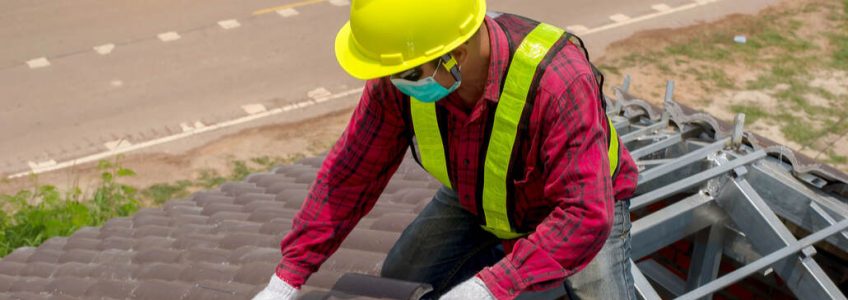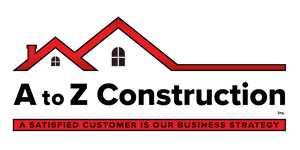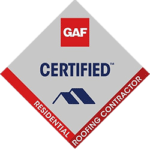
Roof damage is every property owner’s nightmare. Since roofing costs make up about 10% of total construction costs, it can be difficult to decide whether to do a repair or replacement. The cost difference between a roof repair and replacement can quickly add up to thousands of dollars. Making the wrong decision may lead to unnecessary expenditure, leaving a huge dent in your bank account.
While insurance companies may pay for your roof damage costs, not all damage is covered and there might be a push and pull before you get them to pay up. To help you figure out the best way to fix your commercial roofing problems, it’s important to have the damage assessed by a professional roofing contractor.
We’ll break down the differences between roof repair and replacement and when to consider each, to help you better understand your options for your commercial roof.
What to Consider Before Repairing or Replacing a Commercial Roof
Several factors come into play when making the decision about whether to repair or replace your commercial roof. For starters:
1. How Old Is Your Roof?
Every roofing system has an average given lifespan. The age of your roof will determine whether the existing damage is natural wear and tear or due to other factors. If your roof has served its guaranteed lifespan, it may be a good time to consider replacing it. However, if it’s only a few years old, investigate the cause of the damage and determine if it’s easier to repair. For instance, if your roof is leaking due to missing or broken shingles or cracked flashing, a repair by a licensed professional is more fitting to fix the problem
2. What Is the Extent of the Damage?
Extensive roof damage may not always be visible from the outside unless you know exactly what to check for—which is why you need a trusted professional. Minor damages are easier to fix and so a roof repair would be appropriate. However, extensive damage that is visible from outside indicates major roof damage. Signs of major commercial roof damage include:
- Cracked surfaces
- Stagnant water on the roof
- Damaged flashing material
- Presence of mold and algae in the building’s interior
- Interior water stains
A repair in this case would be like putting a bandaid on a deep cut, leading to a series of repairs that are costly in the long run. Think of it this way: If you’ll need a second repair to a particular damage some time soon, then it’s better to replace it once and for all.
3. Time Is Money – How Much Are You Willing To Lose?
Both commercial roof repair and replacement take time, and your business will be disrupted for the duration of the work. That said, roof replacement often takes longer than repairs given the weight of the workload that goes into replacement. If your business can’t afford to take a long break, you may want to consider a repair as a temporary fix then replace your roof at a time when business is slow.
4. Geographical Location Matters
Certain geographical areas are more prone to harsh weather conditions than others. If your commercial building is located in a hurricane or tornado-prone area, it’s important to repair any roof damage as soon as it occurs to avoid major roof damage down the line. Storm damage also affects the lifespan of your roof, so take that into account when choosing the type of roofing material, should you decide to do a replacement.
5. What Is Your Budget?
At the end of the day, the weight of your pocket determines what you can afford. Commercial roof replacement costs way more than roof repairs. However, should you need multiple repairs down the road, the costs will add up may exceed the roof replacement costs.
Once your roofing contractor conducts an assessment of your commercial roof’s damage, they can give you a cost estimate to help you weigh your options. In addition, your roofing contractor can help you find or better yet, provide you with roof financing options to help offset the repair or replacement costs.
Now that you have a clear understanding of what drives the decision between a roof repair and replacement, here’s a quick summary of when to consider either roofing solution.
Roof Repairs
A roof repair involves fixing a section of a roof subjected to damage such as:
- Leaks
- Rust
- Missing roofing materials
- Sagging roof
- Water damage
- And more
Roof repairs can be major or minor, depending on the extent of the damage. That said, roof repairs work best for minor roof damage. After a storm or bad weather, it’s important to inspect your roof for any signs of damage so you can get ahead of the problem before it gets worse. Regular roof repairs and maintenance helps extend your commercial roof’s lifespan, saving you from potential roof replacement.
Roof Replacements
As the word suggests, a roof replacement involves removing all the layers of the old roofing materials and replacing them with new materials. All components are removed and replaced, such as:
- Flashing
- Decking
- Drip edge
- Underlayment
- Vents
- Waterproofing
Commercial roof replacement is most ideal for an old roof that has been weathered down by age. The lifespan of commercial roofs is between 10 to 40 years, depending on the type of roofing material. While the installation costs may be costly, a complete replacement can save you from having to do multiple repairs, which may cost even more than a replacement.
A Professional Roofing Contractor Makes All the Difference
Whether you choose to repair or replace your roof, your choice of contractor can either make it or break it for you. You need an experienced and licensed contractor who will provide you with excellent roofing services to ensure your roof stands the test of time.
At A to Z Construction, quality roofing work and customer satisfaction is the driving force for our business. We handle every project independently and tailor our services to suit every client’s needs. Contact us today for a free roof inspection.









